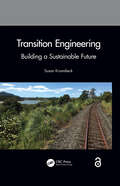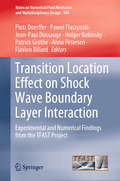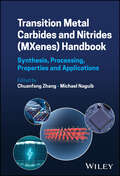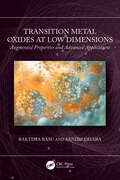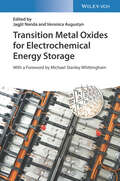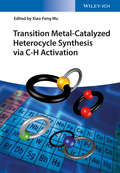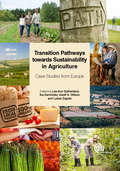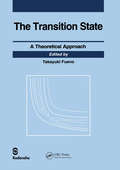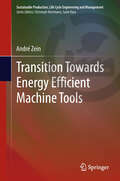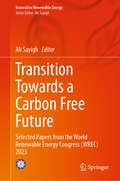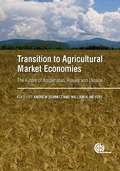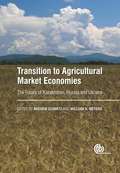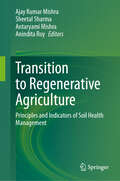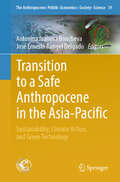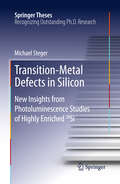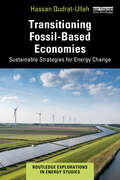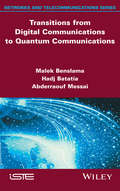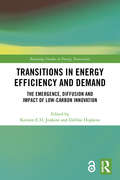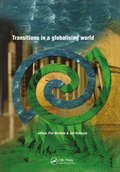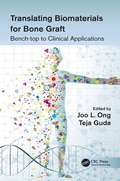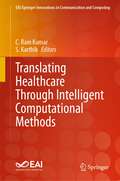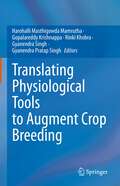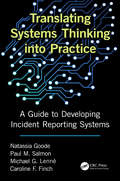- Table View
- List View
Transition Engineering: Building a Sustainable Future
by Susan KrumdieckEngineering Transition: Building a Sustainable Future examines new strategies emerging in response to the mega-issues of global climate change, decline in world oil supply, scarcity of key industrial minerals, and local environmental constraints. These issues pose challenges for organizations, businesses, and communities, and engineers will need to begin developing ideas and projects to implement the transition of engineered systems. This work presents a methodology for shifting away from unsustainable activities. Teaching the Transition Engineering approach and methodology is the focus of the text, and the concept is presented in a way that engineers can begin applying it in their work.
Transition Location Effect on Shock Wave Boundary Layer Interaction: Experimental and Numerical Findings from the TFAST Project (Notes on Numerical Fluid Mechanics and Multidisciplinary Design #144)
by Holger Babinsky Piotr Doerffer Pawel Flaszynski Jean-Paul Dussauge Patrick Grothe Anna Petersen Flavien BillardThis book presents experimental and numerical findings on reducing shock-induced separation by applying transition upstream the shock wave. The purpose is to find out how close to the shock wave the transition should be located in order to obtain favorable turbulent boundary layer interaction. The book shares findings obtained using advanced flow measurement methods and concerning e.g. the transition location, boundary layer characteristics, and the detection of shock wave configurations. It includes a number of experimental case studies and CFD simulations that offer valuable insights into the flow structure. It covers RANS/URANS methods for the experimental test section design, as well as more advanced techniques, such as LES, hybrid methods and DNS for studying the transition and shock wave interaction in detail. The experimental and numerical investigations presented here were conducted by sixteen different partners in the context of the TFAST Project. The general focus is on determining if and how it is possible to improve flow performance in comparison to laminar interaction. The book mainly addresses academics and professionals whose work involves the aerodynamics of internal and external flows, as well as experimentalists working with compressible flows. It will also be of benefit for CFD developers and users, and for students of aviation and propulsion systems alike.
Transition Metal Carbides and Nitrides (MXenes) Handbook: Synthesis, Processing, Properties and Applications
by Chuanfang Zhang Michael NaguibA comprehensive overview of the synthesis of high-quality MXenes In Transition Metal Carbides and Nitrides (MXenes) Handbook: Synthesis, Processing, Properties and Applications, a team of esteemed researchers provides an expert review encompassing the fundamentals of precursor selection, MXene synthesis, characterizations, properties, processing, and applications. You’ll find detailed discussions of the selection of MXene members for specific applications, as along with summaries of the physical and chemical properties of MXenes, including electrical, mechanical, optical, electromechanical, electrochemical, and electromagnetic properties. The authors delve into both successful and unsuccessful synthesis examples, offering detailed explanations of various failures to facilitates a comprehensive understanding of the reasons behind unsuccessful syntheses. Additionally, they provide detailed examinations on the characterizations of MXenes, empowering readers to develop a sophisticated understanding of how to achieve optimal quality, flake size, oxidation states, and more. You’ll also find: A thorough review of common applications of MXenes, including electrochemical applications, electromagnetic interference shielding, communications devices, and more Comprehensive explorations of solution and non-solution processing of MXenes Practical discussions of the synthesis of high-quality MXene powders, colloidal solutions and flakes, including information about MXene precursors Fulsome treatments of MXene precursor selection and their impact on MXene quality Tailored to meet the needs of graduate students, researchers, and scientists in the areas of materials science, inorganic chemistry, and physical chemistry, the Transition Metal Carbides and Nitrides (MXenes) Handbook will also benefit biochemists and professionals working in drug delivery.
Transition Metal Oxides at Low Dimensions: Augmented Properties and Advanced Applications
by Sandip Dhara Raktima BasuThis book covers enhanced properties and cutting-edge applications of transition metal oxides (TMOs) at low dimensions (2D, 1D, and 0D). The electronic bandgap modification and emergence of novel and fascinating properties due to reduced dimension are discussed in detail. It covers various synthesis procedures and advanced technical tools for the characterization of the TMOs at lower dimensions and enhanced properties of the TMOs at lower dimensions realizing ground-breaking applications in advanced energy storage and energy harvesting, catalysis, and chemical sensing.Features: Covers applications and possible devices made of nanoclusters/quantum dots (QDs) and 1D and 2D TMOs Discusses low-dimensional TMOs for advanced properties Explores next-generation advancement in green energy, gas/chemical sensing and photocatalysis Reviews low-cost TMO-based devices with advantage over electronic-grade transition metal dichalcogenides (TMDs) Details physics of 1D TMOs including perspectives from spin wave and charge density wave This book is aimed at researchers and graduate students in materials science.
Transition Metal Oxides for Electrochemical Energy Storage
by Jagjit Nanda Veronica AugustynTransition Metal Oxides for Electrochemical Energy Storage Explore this authoritative handbook on transition metal oxides for energy storage Metal oxides have become one of the most important classes of materials in energy storage and conversion. They continue to have tremendous potential for research into new materials and devices in a wide variety of fields. Transition Metal Oxides for Electrochemical Energy Storage delivers an insightful, concise, and focused exploration of the science and applications of metal oxides in intercalation-based batteries, solid electrolytes for ionic conduction, pseudocapacitive charge storage, transport and 3D architectures and interfacial phenomena and defects. The book serves as a one-stop reference for materials researchers seeking foundational and applied knowledge of the titled material classes. Transition Metal Oxides offers readers in-depth information covering electrochemistry, morphology, and both in situ and in operando characterization. It also provides novel approaches to transition metal oxide-enabled energy storage, like interface engineering and three-dimensional nanoarchitectures. Readers will also benefit from the inclusion of: A thorough introduction to the landscape and solid-state chemistry of transition metal oxides for energy storage An exploration of electrochemical energy storage mechanisms in transition metal oxides, including intercalation, pseudocapacitance, and conversion Practical discussions of the electrochemistry of transition metal oxides, including oxide/electrolyte interfaces and energy storage in aqueous electrolytes An examination of the characterization of transition metal oxides for energy storage Perfect for materials scientists, electrochemists, inorganic chemists, and applied physicists, Transition Metal Oxides for Electrochemical Energy Storage will also earn a place in the libraries of engineers in power technology and professions working in the electrotechnical industry seeking a one-stop reference on transition metal oxides for energy storage.
Transition Metal-Catalyzed Heterocycle Synthesis via C-H Activation
by Xiao-Feng WuReflecting the tremendous growth of this hot topic in recent years, this book covers C-H activation with a focus on heterocycle synthesis. As such, the text provides general mechanistic aspects and gives a comprehensive overview of catalytic reactions in the presence of palladium, rhodium, ruthenium, copper, iron, cobalt, and iridium. The chapters are organized according to the transition metal used and sub-divided by type of heterocycle formed to enable quick access to the synthetic route needed. Chapters on carbonylative synthesis of heterocycles and the application of C-H activation methodology to the synthesis of natural products are also included. Written by an outstanding team of authors, this is a valuable reference for researchers in academia and industry working in the field of organic synthesis, catalysis, natural product synthesis, pharmaceutical chemistry, and crop protection.
Transition Pathways towards Sustainability in Agriculture
by Lukas Zagata Ika Darnhofer Geoff Wilson Lee-Ann SutherlandThis book focuses on understanding farming transition pathways towards sustainability, using case studies from Europe. It assesses the utility of the multi-level perspective in transition theory for addressing contemporary issues and identifies future research needs, making it an essential read for researchers of rural or agricultural change.
Transition Pathways towards Sustainability in Agriculture: Case Studies from Europe
by Lukas Zagata Ika Darnhofer Lee-Ann Sutherland Geoff AThis book focuses on understanding farming transition pathways towards sustainability, using case studies from Europe. It assesses the utility of the multi-level perspective in transition theory for addressing contemporary issues and identifies future research needs, making it an essential read for researchers of rural or agricultural change.
Transition State: A Theoretical Approach
by Takayuki FuenoThe transition state is the critical configuration of a reaction system situated at the highest point of the most favorable reaction path on the potential-energy surface, its characteristics governing the dynamic behavior of reacting systems decisively. This text presents an accurate survey of current theoretical investigations of chemical reactions, with a focus on the nature of the transition state. Its scope ranges from general basic theories associated with the transition states, to their computer-assisted applications, through to a number of reactions in a state-of-the-art fashion. It covers various types of gas-phase elementary reactions, as well as some specific types of chemical processes taking place in the liquid phase. Also investigated is the recently developing transition state spectroscopy. This text will not only serve as a contemporary reference book on the concept of the transition state, but will also assist the readers in gaining valuable key principles regarding the essence of chemical kinetics and dynamics.
Transition Towards Energy Efficient Machine Tools
by André ZeinEnergy efficiency represents a cost-effective and immediate strategy of a sustainable development. Due to substantial environmental and economic implications, a strong emphasis is put on the electrical energy requirements of machine tools for metalworking processes. The improvement of energy efficiency is however confronted with diverse barriers, which sustain an energy efficiency gap of unexploited potential. The deficiencies lie in the lack of information about the actual energy requirements of machine tools, a minimum energy reference to quantify improvement potential and the possible actions to improve the energy demand. Therefore, a comprehensive concept for energy performance management of machine tools is developed which guides the transition towards energy efficient machine tools. It is structured in four innovative concept modules, which are embedded into step-by-step workflow models. The capability of the performance management concept is demonstrated in an automotive manufacturing environment. The target audience primarily comprises researchers and practitioners challenged to enhance energy efficiency in manufacturing. The book may also be beneficial for graduate students who want to specialize in this field.
Transition Towards a Carbon Free Future: Selected Papers from the World Renewable Energy Congress (WREC) 2023 (Innovative Renewable Energy)
by Ali SayighThis book contains selected papers from the 22nd World Renewable Energy Congress (WREC 2023) in Kuala Lumpur. The forum promotes renewable energy global development and features top international experts, policymakers, scientists, engineers, technology developers, and business practitioners addressing the most current research in sustainable energy development and innovation. The contributions address policy, technology, and applications across a wide range of topics, including solar thermal, geothermal energy, wind energy, turbines and generators, bioclimatic architecture, energy audits, construction and design, low carbon mobility, green steel, batteries and supercapacitors, regulatory issues and public policy, circular economy, urban mining and much more.
Transition to Agricultural Market Economies
by David Epstein Andrew Schmitz David Sedik William Liefert Saule Burkitbeyeva Kekaterina Vorotnikova William H Meyers Heinrich Hockmann Lars Brink Kateryna Schroeder Marlene Boersch Suzanne Thornsbury Vasily Erokhin Gershon Feder Axel Wolz Karen Fischer Iryna Kobuta Martin Petrick Uliana Saigusheva Olga Murova Charles Moss Linde GotzIt is believed that the major countries of the former Soviet Union--specifically Kazakhstan, Russia, and Ukraine (KRU region)--are the part of the world with the most potential to increase food supplies and strengthen world food security. This book examines the future of the KRU countries in global agricultural markets and will examine a number of agricultural sectors, including meat, dairy, fruits, and vegetables. However particular attention is paid to the region's potential expansion of the grain sector and why the KRU region emerged during the 2000s as a major grain exporter, and its potential to further expand grain production and exports. It also examine the issues of environmental constraints and trade-offs for agriculture, sustainability, and the possible effects of climate change
Transition to Agricultural Market Economies: The Future of Kazakhstan, Russia and Ukraine
by David Epstein David Sedik William Liefert Saule Burkitbeyeva Kekaterina Vorotnikova Heinrich Hockmann Lars Brink Kateryna Schroeder Marlene Boersch Suzanne Thornsbury Vasily Erokhin Gershon Feder Axel Wolz Karen Fischer Iryna Kobuta Martin Petrick Uliana Saigusheva Olga Murova Charles Moss Linde GotzIt is believed that the major countries of the former Soviet Union—specifically Kazakhstan, Russia, and Ukraine (KRU region)—are the part of the world with the most potential to increase food supplies and strengthen world food security. This book examines the future of the KRU countries in global agricultural markets and will examine a number of agricultural sectors, including meat, dairy, fruits, and vegetables. However particular attention is paid to the region’s potential expansion of the grain sector and why the KRU region emerged during the 2000s as a major grain exporter, and its potential to further expand grain production and exports. It also examine the issues of environmental constraints and trade-offs for agriculture, sustainability, and the possible effects of climate change
Transition to Hydrogen
by Erik Wilhelm Alexander WokaunThis book is a comprehensive and objective guide to understanding hydrogen as a transportation fuel. The effects that pursuing different vehicle technology development paths will have on the economy, the environment, public safety and human health are presented with implications for policy makers, industrial stakeholders and researchers alike. Using hydrogen as a fuel offers a possible solution to satisfying global mobility needs, including sustainability of supply and the potential reduction of greenhouse gas emissions. This book focuses on research issues that are at the intersection of hydrogen and transportation, since the study of vehicles and energy-carriers is inseparable. It concentrates on light duty vehicles (cars and light trucks), set in the context of other competing technologies, the larger energy sector and the overall economy. The book is invaluable for researchers and policy makers in transportation policy, energy economics, systems dynamics, vehicle powertrain modeling and simulation, environmental science and environmental engineering.
Transition to Regenerative Agriculture: Principles and Indicators of Soil Health Management
by Ajay Kumar Mishra Anindita Roy Sheetal Sharma Antaryami MishraThis book explores the crucial transition from conventional to regenerative agricultural practices, focusing on the key drivers and indicators of soil health management. Regenerative agriculture is an approach that aims to restore and enhance soil health, focusing on practices that promote soil fertility, biodiversity, and ecosystem resilience. The theme of the book captures the growing recognition of the urgent need for sustainable agricultural systems that prioritize soil health to address environmental challenges, improve food security, and ensure the long-term viability of agricultural practices. The book covers a wide range of topics related to soil health management in the transition from conventional to regenerative agriculture. It covers the principles and concepts of soil health, the challenges and limitations of conventional agriculture, the assessment of soil health using various indicators, and the importance of cover crops, crop rotation, conservation tillage, nutrient management, and water conservation practices. In addition, the book addresses the role of soil biodiversity, policy frameworks, and scaling up regenerative agriculture, providing practical strategies and case studies. The book provides farmers, policy makers, researchers, and students with the knowledge and tools to implement sustainable agricultural systems that prioritize soil health and promote the transition to regenerative practices.
Transition to a Safe Anthropocene in the Asia-Pacific: Sustainability, Climate Action, and Green Technology (The Anthropocene: Politik—Economics—Society—Science #39)
by José Ernesto Rangel Delgado Antonina Ivanova BonchevaThe Anthropocene concept highlights that we are now living in a new epoch of earth history where both the rapid accumulation of greenhouse gases and excessive consumption of natural resources endanger human and planetary wellbeing. Climate change is one of the main drivers of the Anthropocene and is intricately linked to many great challenges we face: lack of fresh water, food security, biodiversity loss, and human rights of present and future generations. The radical influence of humanity on nature must change from destructive to reconstructive, by the path of sustainable development, circular economy, climate action, green technology, and environmental awareness. This book explores the pathways of transition towards a safe and sustainable Anthropocene in the Asia-Pacific and reviews the progress and the challenges in climate action, the recovery from COVID-19, and the re-articulation of world order. The chapters address both regional and country levels, the majority analysing China and Mexico. The experiences presented can be replicated in other regions of the world. The book offers useful insights for all interested in the Anthropocene, in climate action, sustainability, and the relationship between human beings and nature, thus motivating the decision-makers to implement a just and inclusive transition to a safe Anthropocene. • A novel study that explores links between the Anthropocene, climate change, and sustainability, framing the transition towards a safe and sustainable Anthropocene in the Asia-Pacific. • Strategies and policies on climate action, renewable energies, green technology, and environmental education include the participation of governments, NGOs, and civil society. • Case studies based on experiences at the regional and country level provide valuable insights for both industrialised and developing countries.
Transition-Metal Defects in Silicon
by Michael StegerThe fundamental properties of deep luminescence centres in Si associated with transition metals such as Cu, Ag, Au, and Pt have been a focus of interest for decades, both as markers for these deleterious contaminants, and also in the quest for efficient Si-based light emission. This dissertation presents the results of ultra-high resolution photoluminescence studies of these centres in specially prepared, highly enriched 28-Si samples. The greatly improved spectral resolution due to this enrichment led to the discovery of isotopic fingerprints. These fingerprints have revealed that the detailed constituents of all of the centres previously studied had been identified incorrectly. They also revealed the existence of several different families of impurity complexes containing either four or five atoms chosen from Li, Cu, Ag, Au, and Pt. These centres' constituents have been determined, together with no-phonon transition energies, no-phonon isotope shifts, local vibrational mode energies, and the isotope shifts of the local vibrational mode energies. The data presented here for these centres should prove useful for the currently sought theoretical explanations of their formation, stability, and properties.
Transitioning Fossil-Based Economies: Sustainable Strategies for Energy Change (Routledge Explorations in Energy Studies)
by Hassan Qudrat-UllahThis book offers a comprehensive exploration of the role of fossil-based economies in the global energy transition toward sustainability.The book’s main themes include understanding the challenges and opportunities inherent in transitioning from fossil fuels to renewable energy sources, analyzing the economic, environmental, and social impacts of this transition, and identifying strategies for fostering sustainable practices within fossil-based economies. Through a multidisciplinary lens, this book navigates the complex dynamics of transitioning from fossil fuels to sustainable energy sources, addressing environmental, economic, and social dimensions. From understanding the challenges and opportunities posed by fossil-based practices to exploring successful case studies of green transitions, this book offers actionable insights for policymakers, practitioners, and stakeholders alike. The case studies showcase a range of real-world examples of successful green transitions and initiatives within fossil-based economies. With a visionary approach and a call for collaborative global efforts, this book advocates for a sustainable, equitable, and resilient energy future.This book will be useful for students and researchers studying energy transitions, sustainability, environmental economics, and global policy. It will appeal to professionals working in government agencies, energy companies, environmental organizations, international development agencies, and academic institutions.
Transitions from Digital Communications to Quantum Communications: Concepts and Prospects
by Malek Benslama Hadj Batatia Abderraouf MessaiThis book addresses the move towards quantum communications, in light of the recent technological developments on photonic crystals and their potential applications in systems. The authors present the state of the art on extensive quantum communications, the first part of the book being dedicated to the relevant theory; quantum gates such as Deutsch gates, Toffoli gates and Dedekind gates are reviewed with regards to their feasibility as electronic circuits and their implementation in systems, and a comparison is performed in parallel with conventional circuits such as FPGAs and DSPs. The specifics of quantum communication are also revealed through the entanglement and Bell states, and mathematical and physical aspects of quantum optical fibers and photonic crystals are considered in order to optimize the quantum transmissions. These concepts are linked with relevant, practical examples in the second part of the book, which presents six integrated applications for quantum communications.
Transitions in Energy Efficiency and Demand: The Emergence, Diffusion and Impact of Low-Carbon Innovation (Routledge Studies in Energy Transitions)
by Kirsten E.H. Jenkins Debbie HopkinsThe Open Access version of this book, available at http://www.tandfebooks.com/doi/view/10.4324/9781351127264, has been made available under a Creative Commons Attribution-Non Commercial-No Derivatives 4.0 license. Meeting the goals enshrined in the Paris Agreement and limiting global temperature increases to less than 2°C above pre-industrial levels demands rapid reductions in global carbon dioxide emissions. Reducing energy demand has a central role in achieving this goal, but existing policy initiatives have been largely incremental in terms of the technological and behavioural changes they encourage. Against this background, this book develops a sociotechnical approach to the challenge of reducing energy demand and illustrates this with a number of empirical case studies from the United Kingdom. In doing so, it explores the emergence, diffusion and impact of low-energy innovations, including electric vehicles and smart meters. The book has the dual aim of improving the academic understanding of sociotechnical transitions and energy demand and providing practical recommendations for public policy. Combining an impressive range of contributions from key thinkers in the field, this book will be of great interest to energy students, scholars and decision-makers.
Transitions in a Globalising World
by Pim Martens; Jan RotmansThe Earth System may be the most complex entity that ever emerged in our galaxy and the contemporary process of 'globalisation' may be the most intricate dynamics that will ever pervade that entity: it is the interactive co-evolution of millions of technological, cultural, economic, social and environmental trends at all conceivable spatiotemporal scales that brings about the present fundamental transformation of humanity’s way of life. In this text the authors make the heroic effort to tame the complexity of modern planetary development by the intellectual concept of 'transition'. In this work, four major issues are discussed that are of global importance: developments related to two of our key natural resources; water and biodiversity; the health of human populations; and the developments related to global tourism.
Translating Biomaterials for Bone Graft: Bench-top to Clinical Applications
by Joo L. Ong Teja GudaTranslating Biomaterials for Bone Graft: Bench-top to Clinical Applications brings together the current translational research in bone tissue engineering, from design to application – from materials, drugs and biologic delivery used for bone graft applications to pre-clinical and clinical considerations. The book also discusses the regulatory approval pathways, which involves consideration of the class of devices; whether they are similar to existing solutions, minimal manipulation of donor tissue or completely novel materials, drugs and biologics. These considerations drive the ability to successfully transition the latest generations of bone graft materials into the clinics. Chapters come from materials scientists, clinicians, researchers, and consultants and provide a holistic understanding of the field. As such, the book is a state-of-the-art reference to bone therapies and should appeal to clinicians, scientists, as well as students interested in the current research and/or practices in the field of bone regeneration and restoration.
Translating Healthcare Through Intelligent Computational Methods (EAI/Springer Innovations in Communication and Computing)
by C. Ram Kumar S. KarthikThis book provides information on interdependencies of medicine and telecommunications engineering and how Covid exemplifies how the two must rely on each other to effectively function in this era. The book discusses new techniques for medical service improvisation such as clear cut views on medical technologies. The authors provide chapters on processing of medical amenities using medical images, the importance of data and information technology in medicine, and machine learning and artificial intelligence in healthcare. Authors include researchers, academics, and professionals in the field of communications engineering with a variety of perspectives.
Translating Physiological Tools to Augment Crop Breeding
by Gyanendra Pratap Singh Harohalli Masthigowda Mamrutha Gopalareddy Krishnappa Rinki Khobra Gyanendra SinghThis book covers different physiological processes, tools, and their application in crop breeding. Each chapter emphasizes on a specific trait/physiological process and its importance in crop, their phenotyping information and how best it can be employed for crop improvement by projecting on success stories in different crops. It covers wide range of physiological topics including advances in field phenotyping, role of endophytic fungi, metabolomics, application of stable isotopes, high throughput phenomics, transpiration efficiency, root phenotyping and root exudates for improved resource use efficiency, cuticular wax and its application, advances in photosynthetic studies, leaf spectral reflectance and physiological breeding in hardy crops like millets. This book also covers the futuristic research areas like artificial intelligence and machine learning. This contributed volume compiles all application parts of physiological tools along with their advanced research in these areas, which is very much need of the hour for both academics and researchers for ready reference. This book will be of interest to teachers, researchers, climate change scientists, capacity builders, and policy makers. Also, the book serves as additional reading material for undergraduate and graduate students of agriculture, physiology, botany, ecology, and environmental sciences. National and international agricultural scientists will also find this a useful resource.
Translating Systems Thinking into Practice: A Guide to Developing Incident Reporting Systems
by Paul M. Salmon Natassia Goode Michael Lenne Caroline FinchSystems thinking tells us that human error, violations and technology failures result from poorly designed and managed work systems. To help us understand and prevent injuries and incidents, incident reporting systems must be capable of collecting data on contributory factors from across the overall work system, in addition to factors relating to the immediate context of the event (e.g. front-line workers, environment, and equipment). This book describes how to design a practical, usable incident reporting system based on this approach. The book contains all the information needed to effectively design and implement a new incident reporting system underpinned by systems thinking. It also provides guidance on how to evaluate and improve existing incident reporting systems so they are practical for users, collect good quality data, and reflect the principles of systems thinking. Features Highlights the key principles of systems thinking for designing incident reporting systems Outlines a process for developing and testing incident reporting systems Describes how to evaluate incident reporting systems to ensure they are practical, usable, and collect good quality data Provides detailed guidance on how to analyze incident data, and translate the findings into appropriate incident prevention strategies
